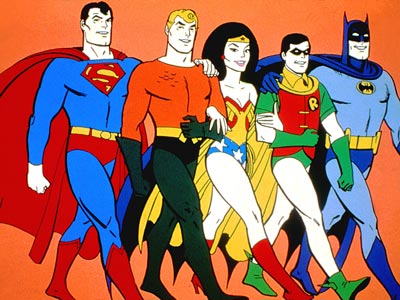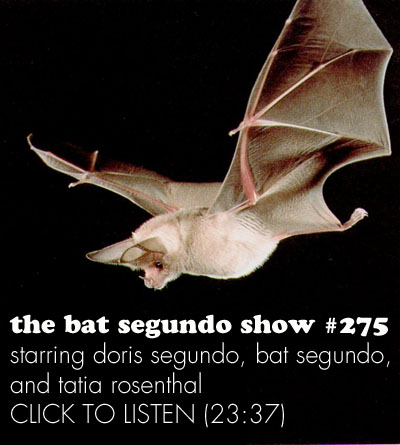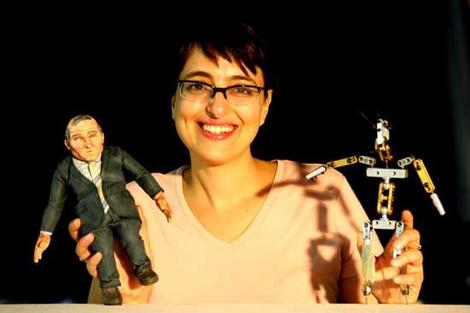“This is your money. Give me a smoking.”
Category / Animation

Super Friends: An Origin Point

It is difficult to explain the now extinct Saturday morning cartoon experience to anybody under twenty-five, but it shared certain qualities with a Sunday morning religious service, where one dressed in ratty pajamas and multihued Underoos in lieu of serge suit and neck-restricting tie. A soaky bowl of cornflakes replaced the stale sacramental pomp and circumstance of wafers, offering an altogether different eucharist metaphor with slightly more nutritional value. Leaden and predictable hymns, in which one was badgered into belting out a tinny tune identified by number, were uprooted by Hoyt Curtin’s jazzy cues for Hanna-Barbera. And the ethical lessons arising from a pastor’s ponderous sermon found an uncanny surrogate with the didactic messages tacked onto the end of an animated adventure. Both slipped through the mind like a sieve.
But since nostalgia is a dangerous narcotic, the cartoons have retained an entirely irrational hold upon my imagination. Years later, a piece of dialogue or a backdrop hastily painted by an underpaid artist has often rustled through my mind without prompting, latching atop a more tangible life experience and sometimes threatening to supercede it.
With the recent release of Super Friends‘s first season onto DVD, I set out to understand this allure and found an oddly methadonic satisfaction. If I did not entirely put away childish things during this revistation, I certainly began to understand the draw.
In the early 1970s, Hanna-Barbera wrested away the animation rights to DC Comics’s characters, restyling the Justice League of America as “Super Friends.” It was the beginning of a gallant fourteen year run under numerous incarnations. Challenge of the Super Friends was the best of the bunch, pitting eleven superheroes (which included the newly invented Apache Chief and Samurai, both awkward nods to multiculturalism) against thirteen of their worst enemies (led by Lex Luthor) who never offered an explanation as to why they spent so much of their time shuffling around the swampy Hall of Doom. But in other versions, such as The World’s Greatest Super Friends, one had to endure Zan and Jayna – a somewhat vexing pair of siblings clad in cheesy purple uniforms, accompanied by a blue monkey named Gleek. (Presumably, fashionistas did not exist on the planet Exxor. Or maybe everybody there just liked bluish tones.) This teen duo, who had a surprisingly crisp command of American teen vernacular (or so the writers wished to believe), could, respectively, turn into water form and animal form shortly after announcing “Wonder Twin powers, activate!” Due to this verb’s alarming mechanical quality, there was considerable schoolyard speculation over whether the Wonder Twins were elaborate androids rather than extraterrestrial beings. But at the time, all of us wanted to believe in this cartoon – in part because there were then only three networks and a wild mix of UHF stations to choose from.
But the flagstones for this escapist enterprise were set down with the first season’s one-hour format, which featured a mere five superheroes (Superman, Batman, Robin, Aquaman, and a curiously underemployed Wonder Woman), while cadging archetypes and vocal talent from Scooby-Doo. The quintet that everyone tuned in to see was accompanied by three “junior superheroes,” who proved to be infinitely more annoying than the Wonder Twins: Marvin White, a redheaded Shaggy clone voiced by a young (and now legendary) “Franklin Welker,” who proved to be even stupider than his inspiration (“Wow, I’d like to be big and strong,” says Marvin in an episode called “The Shaman ‘U’,” which is then followed by a Peter Griffin-style titter); Wendy Harris, who merged Velma’s eccentricities with Daphne’s patient encouragement; and Wonder Dog, a spaced-out Scooby replica fond of scarfing down hot dogs. This trio, possessing neither pluck nor superpowers, proved so unremarkable (and unlikable) that they did not last past the first season. (Comic book writer Geoff Johns would later viciously mutilate these irksome tagalongs in a 2006 issue of Teen Titans.)
Considering these conversational conditions and Colonel Wilcox’s constant interruptions on the TroubAlert, the Super Friends’s patience is to be commended. In early episodes, Batman made futile efforts to get Marvin thinking about photosynthesis and atmospheric conditions. But by “The Shaman ‘U’,” this friendlier (and more dulcet-voiced) Dark Knight leveled with Marvin when the boy wished to accompany him, simply explaining, “We’re not taking you with us.” I can understand Batman’s reticence. Robin was a competent teenage sidekick (voiced by longtime American Top 40 host Casey Kasem) only a few years older than Marvin, but, in the hands of Hanna-Barbera, he was never a noxious pipsqueak.
While this prototype offers some unintentional laughs courtesy of tacky animation (Wonder Woman is inexplicably illustrated with thunder thighs, an animation involving Aquaman summoning three whales shows up multiple times, and Superman’s X-ray vision resembles a cheap flashlight running on dying batteries), there’s an interesting eco-friendly theme to these stories. In “Too Hot to Handle,” an alien attempts to change the Earth’s atmosphere after his home planet has become polluted. “The Weather Maker” features a scientist attempting to manipulate the Gulf Stream so that it will warm up his frigid nation. “Dr. Pelagion’s War” features a scene that is now unthinkable, where business magnates puff on expensive cigars in an executive boardroom. One cries out, “There’s no harm in a little smoke,” and offers a flourish to the smokestacks fulminating just outside his window.
But the standout here is the accidentally prescient “Professor Goodfellow’s G.E.E.C.,” whereby a giant Google-like computer named G.E.E.C. controls everything on the planet. Like Google, it can find you a cab. Like YouTube, it can educate you with a video. At the time that Super Friends was produced, “geek” didn’t yet take on its present tech-savvy connotation. And when Marvin offers to “write a letter to the G.E.E.C.,” one can just as easily imagine him firing off an email.
Narrator Ted Knight (who would find greater success as the bumbling Ted Baxter on The Mary Tyler Moore Show) doesn’t quite have the gravitas of his booming successor, William Woodson. And the primitive transitions between scenes can’t compare to the three stars shooting towards the viewer in later years. But Robin’s exclamations were more epigrammatic during the first year. (He lets loose “Holy misnomers!” and “Perambulating plexiglass!”) Danny Dark, later known as “the voice of NBC,” is suitably slick, perhaps too slick, as Superman. Dark’s confident voiceover, taken with Superman’s frequent collaboration with Aquaman to resolve some amphibian crisis, makes one feel as if poor Aquaman, who merely has the ability to communicate telepathically with his “ocean friends,” is unfairly upstaged by Superman’s considerable talents.
These were imperfect entertainments, divested of grit and violence, that would be severely dwarfed by the Cartoon Network’s Justice League during the 21st century. But someone had to work out the kinks and get kids excited. Super Friends‘s enduring appeal can be measured by the limitless YouTube remixes, the unceasing flow of cultural reference (a recent episode of Family Guy opened with a parody of the opening credits), and the fact that superheroes, even those contained in watered-down narratives, still capture the imagination.
Get Parkour
Pigeon Impossible

The Bat Segundo Show: Tatia Rosenthal
Tatia Rosenthal appeared on The Bat Segundo Show #275.
Tatia Rosenthal is is most recently the director of $9.99. The film is presently playing at the New Directors/New Films series, which is running between March 25 and April 5 at MOMA and the Film Society of Lincoln Center. It is also scheduled for limited release on June 17, 2009.
Condition of Mr. Segundo: Ushering in an economic revolution.
Guest: Tatia Rosenthal
Subjects Discussed: Unintentionally defying the “good things come in threes” maxim, animating at two frames per movement, Bill Plympton, the aesthetic advantages of budget limitations, character proportions in relation to the sets, camera placement, a shared affinity for short lenses, immersing puppets in shadow, dealing with sweat in animation, animating natural elements, “A Buck’s Worth” as template for $9.99 (YouTube link), compositing vs. in-camera stop-motion animation, shrinking the Lilliputian puppets down in post, sticking to scale parameters, the look of the piggy bank, human mouths and animating Os, the problems of animating dialogue, whether animation must have fantastical elements to be “animation,” magical realism, animating eyes and blinking, breaking away from stereotypical body movement and defying cliches in animation, animating multiple characters in the Show and Tell scene, Anthony Elworthy, ambition, tracking shots, color coordination, self-help books, and graphical elements.

EXCERPT FROM SHOW:
Correspondent: The other thing I wanted to note is sweat in this film, and bodily fluids in general. Now we see sweat in a love scene late in the film and also in the elevator. However, going back to this question of lighting, I should point out that you lit this in such a way so it appears that the texture is sweating, even though it isn’t. So I’m wondering about how you dealt with this idea of actually having to put some sort of moisture on the puppets in order to get that sense of seat. And not only that. You also have to animate that as well. So I’m curious how this came about.
Rosenthal: I think you’re going to be surprised by the answer. Did you like it?
Correspondent: Yeah, I did.
Rosenthal: Interesting. Because it was an accident. And we were doing our best to conceal the sweaty look. Because the silicone actually appears shiny and looks like sweat. The material that we used. And we were doing our damnedest to erase it with powders and stuff like that. And then some of it would get revealed. Because the animators were touching the puppets. And they looked like they gradually were sweating. And then when we got to post, what we did, when it was really distracting, we deleted it frame-by-frame.
Correspondent: Really?
Rosenthal: Painstakingly. And the places where it stayed were the places where it felt appropriate to the scene. Like you’re remarking. So it was really sweating in reverse.
Correspondent: Oh, but I like sweat! Characters should sweat. Puppets should sweat.
Rosenthal: I like it now.
(Photo: Quentin Jones)
BSS #275: Tatia Rosenthal (Download MP3)
Listen: Play in new window | Download
